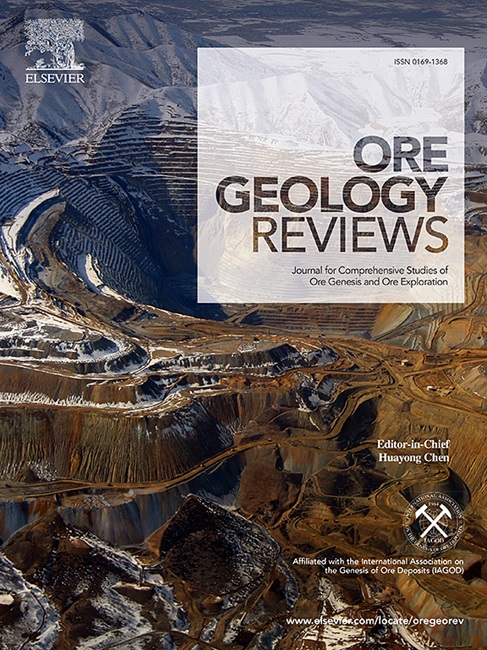阿尔泰造山带二叠系—侏罗系大型稀有金属成矿作用综述
IF 3.2
2区 地球科学
Q1 GEOLOGY
引用次数: 0
摘要
阿尔泰造山带是中亚造山带的重要组成部分,是世界上重要的稀有金属(Li - be - nb - Ta - Sn-W)成矿大省,盛产富含LCT (Li, Cs, Ta)的伟晶岩矿床、花岗岩型Li- rb矿床、硅土型Li矿床、灰岩型和石英脉型Sn-W矿床。阿尔泰省由南向北分为三个成矿期:早二叠世(297-272 Ma) Kalba-Narym带、晚二叠世(274-253 Ma)南阿尔泰带和晚三叠世-早侏罗世(230-180 Ma)北阿尔泰带,其中晚期北阿尔泰带成矿数量最多。稀有金属成矿与花岗质侵入体同生,部分侵入体为贫瘠,部分侵入体为矿化。贫花岗岩分异小,体积大(表面约10 km2),在高温(700 ~ 850℃)下侵位;与成矿作用相关的矿化花岗岩分异强,体积小(表面约5 km2),在低温(600 ~ 650℃)下侵位。Hf和Nd同位素数据表明,贫岩浆和矿化岩浆来源于幼年和古地壳。稀有金属矿化主要与源自古地壳的花岗岩有关。岩浆分馏模式已被广泛接受用于稀有金属矿床的成因,包括LCT伟晶岩矿床、花岗岩型Li-Rb矿床、灰岩型和石英脉型Sn-W矿床。研究结果表明,北阿尔泰带的成矿作用与泥盆纪花岗岩的熔融作用和岩浆分馏作用有关。卡尔巴-纳里姆带和南阿尔泰带的成矿作用发生在伊尔齐什-再桑洋闭合后,西伯利亚克拉通与哈萨克-准噶尔地块的二叠纪碰撞过程中。北阿尔泰带沉积形成于中生代板内伸展期。伟晶岩和花岗岩的矿床位置与靠近区域断裂的正、负重力异常过渡带重合,表明该带有利于矿化岩浆的侵入。另一方面,重力负异常区赋存着灰岩-石英脉型锡钨矿床,表明锡钨矿床为低密度岩石赋存。因此,北阿尔泰带大规模稀有金属矿化的形成,除了强烈的岩浆分馏作用外,泥盆纪花岗岩的富集、重力异常梯度陡的位置、古地壳岩浆的衍生以及中生代由收缩到伸展的构造环境等因素都起到了关键作用。本文章由计算机程序翻译,如有差异,请以英文原文为准。
Large-scale Permian-Jurassic rare-metal mineralization in the Altai Orogenic Belt: A review
The Altai Orogenic Belt, a key part of the Central Asian Orogenic Belt, is an important rare-metal (Li–Be–Nb–Ta–Sn–W) metallogenic province in the world, containing pegmatite deposits enriched in LCT (Li, Cs, Ta), granite-hosted Li-Rb deposits, ongonite Li deposits, greisen and quartz-vein hosted Sn-W deposits. The Altai provinde comprises three metallogenic belts in three mineralization periods: early Permain (297–272 Ma) Kalba-Narym belt, late Permian (274–253 Ma) South Altai belt and late Triassic–early Jurrasic (230–180 Ma) North Altai belt from south to north, and the largest number of deposits occurred in the last period North Altai belt. The rare metal mineralization is contemporaneous with granitic intrusions where some intrusions are barren, and the other are mineralized. Barren granites are less fractionated and large (>10 km2 on the surface), and were emplaced at high temperature (700–850 °C), whereas the mineralized granites, related to the mineralization, are strongly fractionated and small (<5 km2 on the surface), and were emplaced at low temperature (600–650 °C). Hf and Nd isotope data suggest that barren and mineralized magmas were derived from juvenile and ancient crust. The predominant rare-metal mineralzation is associated with granites derived from ancient crust. The magmatic fractionation model has been widely accepted for the genesis of the rare metal deposits, including LCT pegmatite deposits, granite-hosted Li-Rb deposits, greisen and quartz-vein hosted Sn-W deposits. Our data suggest melting of Devonian granite with enrichment in rare metals and magmatic fractionation explains the mineralization in the North Altai belt.
The mineralization in the Kalba-Narym and South Altai belts took place during the Permian collision between Siberia Craton and Kazakhstan-Junggar Block after the closure of the Irtysh-Zaisan Ocean. In contrast, the deposits in the North Altai belt formed during the Mesozoic intraplate extension. The sites for pegmatite and granite deposits coincide with the transitional zone of positive and negative gravity anomalies in the proximity to the regional fault, suggesting that this zone is favourable for the intrusion of the mineralized magma. On the other hand, the areas with negative gravity anomalies host greisen-quartz-vein Sn-W deposits, confirming that the Sn-W deposits are hosted by low-density rocks. Therefore, except for strongly magmatic fractionation, the existence of enriched Devonian granite, site of steep gravity anomaly gradient, derivation of magma from ancient crustal rocks and the tectonic setting from the contraction to extension in the Mesozoic played a key role in the formation of large-scale rare metal mineralzation in the North Altai belt.
求助全文
通过发布文献求助,成功后即可免费获取论文全文。
去求助
来源期刊

Ore Geology Reviews
地学-地质学
CiteScore
6.50
自引率
27.30%
发文量
546
审稿时长
22.9 weeks
期刊介绍:
Ore Geology Reviews aims to familiarize all earth scientists with recent advances in a number of interconnected disciplines related to the study of, and search for, ore deposits. The reviews range from brief to longer contributions, but the journal preferentially publishes manuscripts that fill the niche between the commonly shorter journal articles and the comprehensive book coverages, and thus has a special appeal to many authors and readers.
 求助内容:
求助内容: 应助结果提醒方式:
应助结果提醒方式:


